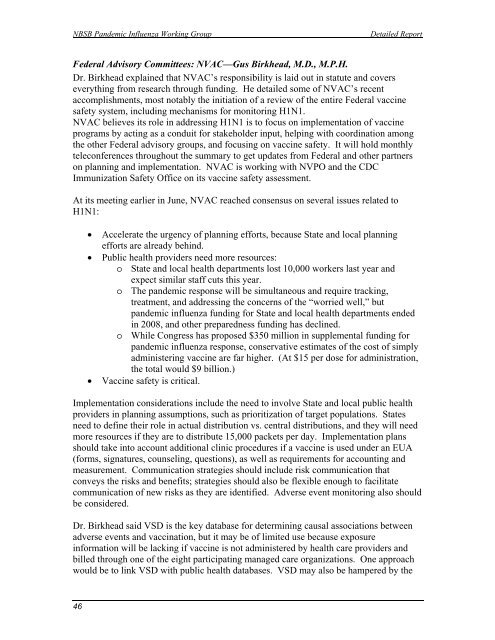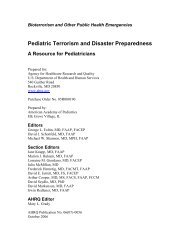H1N1 COUNTERMEASURES STRATEGY AND ... - PHE Home
H1N1 COUNTERMEASURES STRATEGY AND ... - PHE Home
H1N1 COUNTERMEASURES STRATEGY AND ... - PHE Home
You also want an ePaper? Increase the reach of your titles
YUMPU automatically turns print PDFs into web optimized ePapers that Google loves.
NBSB Pandemic Influenza Working Group<br />
Detailed Report<br />
Federal Advisory Committees: NVAC—Gus Birkhead, M.D., M.P.H.<br />
Dr. Birkhead explained that NVAC’s responsibility is laid out in statute and covers<br />
everything from research through funding. He detailed some of NVAC’s recent<br />
accomplishments, most notably the initiation of a review of the entire Federal vaccine<br />
safety system, including mechanisms for monitoring <strong>H1N1</strong>.<br />
NVAC believes its role in addressing <strong>H1N1</strong> is to focus on implementation of vaccine<br />
programs by acting as a conduit for stakeholder input, helping with coordination among<br />
the other Federal advisory groups, and focusing on vaccine safety. It will hold monthly<br />
teleconferences throughout the summary to get updates from Federal and other partners<br />
on planning and implementation. NVAC is working with NVPO and the CDC<br />
Immunization Safety Office on its vaccine safety assessment.<br />
At its meeting earlier in June, NVAC reached consensus on several issues related to<br />
<strong>H1N1</strong>:<br />
<br />
<br />
<br />
Accelerate the urgency of planning efforts, because State and local planning<br />
efforts are already behind.<br />
Public health providers need more resources:<br />
o State and local health departments lost 10,000 workers last year and<br />
expect similar staff cuts this year.<br />
o The pandemic response will be simultaneous and require tracking,<br />
treatment, and addressing the concerns of the “worried well,” but<br />
pandemic influenza funding for State and local health departments ended<br />
in 2008, and other preparedness funding has declined.<br />
o While Congress has proposed $350 million in supplemental funding for<br />
pandemic influenza response, conservative estimates of the cost of simply<br />
administering vaccine are far higher. (At $15 per dose for administration,<br />
the total would $9 billion.)<br />
Vaccine safety is critical.<br />
Implementation considerations include the need to involve State and local public health<br />
providers in planning assumptions, such as prioritization of target populations. States<br />
need to define their role in actual distribution vs. central distributions, and they will need<br />
more resources if they are to distribute 15,000 packets per day. Implementation plans<br />
should take into account additional clinic procedures if a vaccine is used under an EUA<br />
(forms, signatures, counseling, questions), as well as requirements for accounting and<br />
measurement. Communication strategies should include risk communication that<br />
conveys the risks and benefits; strategies should also be flexible enough to facilitate<br />
communication of new risks as they are identified. Adverse event monitoring also should<br />
be considered.<br />
Dr. Birkhead said VSD is the key database for determining causal associations between<br />
adverse events and vaccination, but it may be of limited use because exposure<br />
information will be lacking if vaccine is not administered by health care providers and<br />
billed through one of the eight participating managed care organizations. One approach<br />
would be to link VSD with public health databases. VSD may also be hampered by the<br />
46
















